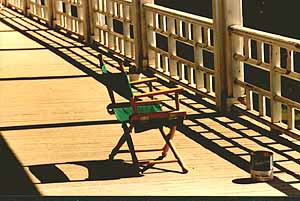Thinking about Mr. Clemens
today on the centenary of his death, there remains to be found any
direct account of his visiting Yosemite. Circumstantial evidence
suggests he was here, though. First, his reference in Roughing
It, Chapter LXI (second-to-last paragraph):
"Our wanderings were wide
and in many directions; and now I could give the reader a vivid
description of the Big Trees and the marvels of the Yo Semite--but
what has this reader done to me that I should persecute him? I will
deliver him into the hands of less conscientious tourists and take
his blessing. Let me be charitable, though I fail in all virtues
else."
Judging from a casual online search, it appears that Clemens may have visited
Yosemite
anytime between 1861 and 1871, having been in the vicinity. Then
there's his lovely critique of Bierstadt's "The Domes Of
Yosemite" reproduced at Twainquotes:
San Francisco Alta California, August 4,
1867
New York,
June 2d, 1867.
"THE DOMES OF THE YOSEMITE"
THAT is the name of Bierstadt's last picture. The art critics
here abused it without stint when its exhibition began, a month ago.
They ridiculed it so mercilessly that I thought it surely could not
be worth going to see, and so I staid away. I went to-day, however,
and I think it is very well worth going to see. It is very beautiful
- considerably more beautiful than the original.
You stand twelve hundred feet above the valley, and look up it
toward the east, with the North Dome on the left and the South Dome
on the right. The rugged mountain range beyond the latter sweeps
round to the right and shuts up the valley, and, springing up among
the clouds in the distance, you see one or two great peaks clad in
robes of snow. Well, the bird's-eye view of the level valley, with
its clusters of diminished trees and its little winding river, is
very natural, and familiar, and pleasant to look upon. The pine
trees growing out of clefts in a bold rock wall, in the right
foreground, are very proper trees, and the grove of large ones, in
the left foreground, and close at hand, are a true copy of Nature,
and so are the various granite boulders in the vicinity.
Now, to sum up the picture's merits, those snow-peaks are correct
- they look natural; the valley is correct and natural; the pine
trees clinging to the bluff on the right, and the grove on the left,
and the boulders, are all like nature; we will assume that the domes
and things are drawn accurately. One sees these things in all sorts
of places throughout California, and under all sorts of
circumstances, and gets so familiar with them that he knows them in
a moment when he sees them in a picture. I knew them in Bierstadt's
picture, and checked them off one by one, and said "These
things are correct - they all look just as they ought to look, and
they all belong to California. " But when I got around to the
atmosphere, I was obliged to say "This man has imported this
atmosphere; this man has surely imported this atmosphere from some
foreign country, because nothing like it was ever seen in
California." I may be mistaken, for all men are liable to err,
but I honestly think I am right. The atmospheric effects in that
picture are startling, are full of variety, and are charming. It is
more the atmosphere of Kingdom-Come than of California.
The time is early morning; the eastern heavens are filled with
shredded clouds, and these afford the excuse for the dreamy lights
and shadows that play about the leftward precipices and the great
dome - a rich blending of softest purple, and gray, and blue, and
brown and white, instead of the bald, glaring expanse of rocks and
earth splotched with cloud-shadows like unpoetical ink-blots which
one ought to see in a Californian mountain picture when correctly
painted. Some of Mr. Bierstadt's mountains swim in a lustrous,
pearly mist, which is so enchantingly beautiful that I am sorry the
Creator hadn't made it instead of him, so that it would always
remain there. In the morning, the outlines of mountains in
California, even though they be leagues away, are painfully bold and
sharp, because the atmosphere is so pure and clear - but the
outlines of Mr. Bierstadt's mountains are soft and rounded and
velvety, which is a great improvement on nature.
As a picture, this work must please, but as a portrait I do not
think it will answer. Portraits should be accurate. We do not want
feeling and intelligence smuggled into the pictured face of an
idiot, and we do not want this glorified atmosphere smuggled into a
portrait of the Yosemite, where it surely does not belong. I may be
wrong, but still I believe that this atmosphere of Mr. Bierstadt's
is altogether too gorgeous.
